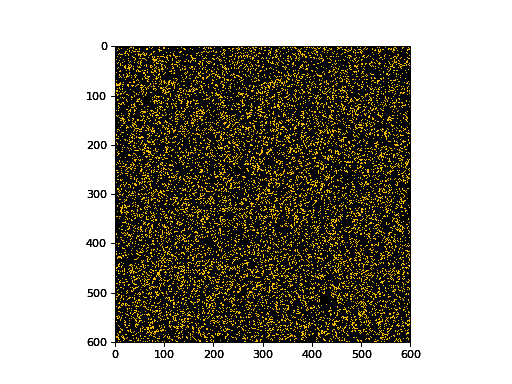
Like a flower in full bloom, nature reveals its patterns shaped by mathematics. Or as particles collide with one another, they create snowflake-like fractals through emergence. How do fish swarm in schools or consciousness come about from the brain? Simulations can provide answers.
Through code, you can simulate how living cells or physical particles would interact with one another. Using equations that govern the behavior of how cells act when they meet one another or how they would grow and evolve into larger structures. In the gif above, you can use diffusion-limited aggregation to create Brownian trees. These are the structures that emerge when particles move randomly with respect to one another. Particles in fluid (like dropping color dye into water) take these patterns when you look at them under a microscope. As the particles collide and form trees, they create shapes and patterns like water crystals on glass. These visuals can give you a way of appreciating how beautiful mathematics is. The way mathematical theory can borrow from nature and how biological communities of living organisms themselves depend on physical laws shows how such an interdisciplinary approach provides a way to bridge different disciplines.

In the code, the particles are set to move with random velocities in two dimensions and, if they collide with the tree (a central particle at the beginning), they form parts of the tree. As the tree grows bigger over time, it takes the shapes of branches the same way neurons in the brain form trees that send signals between one another. These fractals, in their uniqueness, give them a kind of mathematical beauty.

Flashing lights coming and going away like stars shining in the sky are more than just randomness. These models of cellular interactions are known as cellular automaton. The gif above shows an example of Conway’s game of life, a simulation of how living cells interact with one another.
These cells “live” and “die” according to four simple rules: (1) live cells with fewer than two live neighbors die, as if by underpopulation, (2) live cells with two or three live neighbors live on to the next generation, (3) live cells with more than three live neighbors die, as if by overpopulation and (4) dead cells with exactly three live neighbors become live cells, as if by reproduction.

Through these rules, specific shapes emerge such as “gliders” or “knightships” you can further describe with rules and equations. You’ll find natural versions of cells obeying rules like the colorful patterns on a seashell. Complex structures emerging from more basic, fundamental sets of rules unite these observations. While the beauty of these structures becomes more and more apparent from the patterns between different disciplines, searching for these patterns in other contexts can be more difficult such as human behavior.
Recent writing like Genesis: The Deep Origin of Societies by biologist E.O. Wilson take on the debate over how altruism in humans evolved. While the shape of snowflakes can emerge from the interactions between water molecules, humans getting along with one another seems far more complicated and higher-level. Though you can find similar cooperation in ants and termites creating societies, how did science let this happen?
Biologists have answered that organisms choose to mate with individuals and increase the survival chances of themselves and their offspring while passing on their genes. Though they’ve argued this for decades, Wilson offers a contrary point of view. In groups, selfish organisms defeat altruistic ones, but altruistic groups beat selfish groups overall. This group selection drives the emergence of altruism. Through these arguments, both sides have appealed to the mathematics of nature, showing its growing importance in recognizing the patterns of life.
Wilson clarifies that data analysis and mathematical modeling should come second to the biology itself. Becoming experts on organisms themselves should be a priority. Regardless of what form it takes, the beauty is still there, even if it’s below the surface.